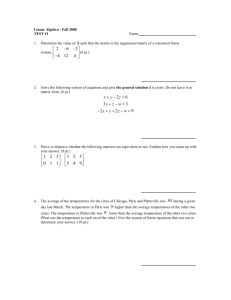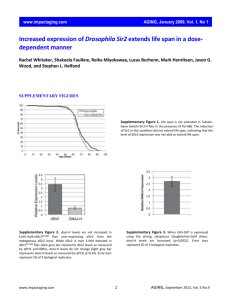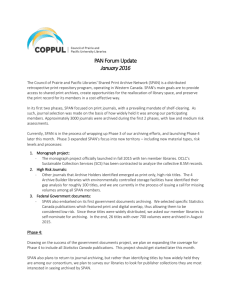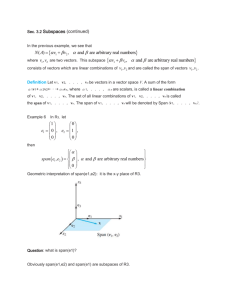foreign languages core 2014 draft compliance plan
advertisement
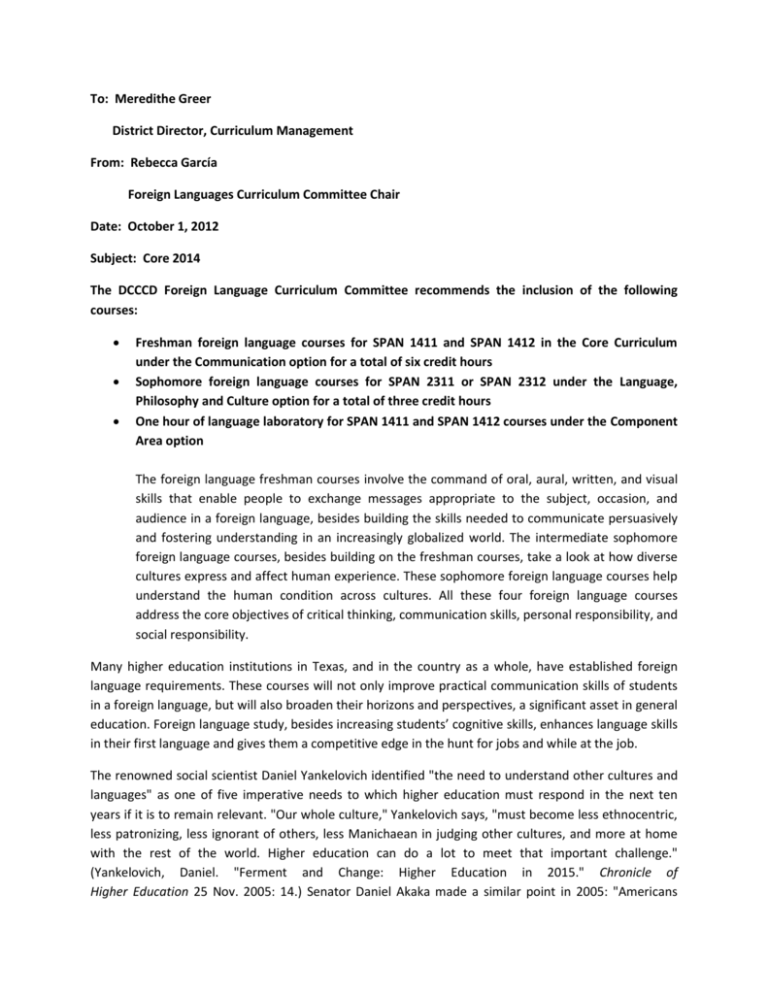
To: Meredithe Greer District Director, Curriculum Management From: Rebecca García Foreign Languages Curriculum Committee Chair Date: October 1, 2012 Subject: Core 2014 The DCCCD Foreign Language Curriculum Committee recommends the inclusion of the following courses: Freshman foreign language courses for SPAN 1411 and SPAN 1412 in the Core Curriculum under the Communication option for a total of six credit hours Sophomore foreign language courses for SPAN 2311 or SPAN 2312 under the Language, Philosophy and Culture option for a total of three credit hours One hour of language laboratory for SPAN 1411 and SPAN 1412 courses under the Component Area option The foreign language freshman courses involve the command of oral, aural, written, and visual skills that enable people to exchange messages appropriate to the subject, occasion, and audience in a foreign language, besides building the skills needed to communicate persuasively and fostering understanding in an increasingly globalized world. The intermediate sophomore foreign language courses, besides building on the freshman courses, take a look at how diverse cultures express and affect human experience. These sophomore foreign language courses help understand the human condition across cultures. All these four foreign language courses address the core objectives of critical thinking, communication skills, personal responsibility, and social responsibility. Many higher education institutions in Texas, and in the country as a whole, have established foreign language requirements. These courses will not only improve practical communication skills of students in a foreign language, but will also broaden their horizons and perspectives, a significant asset in general education. Foreign language study, besides increasing students’ cognitive skills, enhances language skills in their first language and gives them a competitive edge in the hunt for jobs and while at the job. The renowned social scientist Daniel Yankelovich identified "the need to understand other cultures and languages" as one of five imperative needs to which higher education must respond in the next ten years if it is to remain relevant. "Our whole culture," Yankelovich says, "must become less ethnocentric, less patronizing, less ignorant of others, less Manichaean in judging other cultures, and more at home with the rest of the world. Higher education can do a lot to meet that important challenge." (Yankelovich, Daniel. "Ferment and Change: Higher Education in 2015." Chronicle of Higher Education 25 Nov. 2005: 14.) Senator Daniel Akaka made a similar point in 2005: "Americans need to be open to the world; we need to be able to see the world through the eyes of others if we are going to understand how to resolve the complex problems we face." (http://akaka.senate.gov/public/index.cfm?FuseAction=speeches.home&month=5&year=2005&release _id=368) In the context of globalization, while the usefulness of studying English has increased all over the world, the study of foreign languages in the USA is also no longer a matter of debate. While the study of a language is instrumental, a skill essential for communicating thought and information, one must emphasize that language does not grow in a vacuum. It is the embodiment of the way of being, and of living, of a linguistic community, a people, a nation. It has been said, not without reason, that a person speaking two languages possesses not one, but two souls. An MLA report states: ‘language is understood as an essential element of a human being's thought processes, perceptions, and selfexpressions; and as such it is considered to be at the core of trans-lingual and trans-cultural competence. While we use language to communicate our needs to others, language simultaneously reveals us to others and to ourselves. Language is a complex multifunctional phenomenon that links an individual to other individuals, to communities, and to national cultures … Culture is represented not only in events, texts, buildings, artworks, cuisines, and many other artifacts but also in language itself. Expressions such as "the pursuit of happiness," "liberté, égalité, fraternité," “chaltaa hai”, and "la Raza" connote cultural dimensions that extend well beyond their immediate translation. As recent world events have demonstrated, deep cultural knowledge and linguistic competence are equally necessary if one wishes to understand people and their communities. (http://www.mla.org/flreport) We, at the community colleges, besides keeping in mind the instrumentalist view of language study to cater to the needs of the students that we serve, also initiate our students to take tentative first steps towards the ultimate goal of a foreign language major as enunciated in the report quoted above. The desired result will be achieving deep trans-lingual and trans-cultural competence, placing value on the ability to operate between languages, systematically teaching differences in meaning, mentality, and worldview as expressed in American English and in the target language. Literature, film, and other media are used to challenge students' imaginations and to help them consider alternative ways of seeing, feeling, and understanding things. They are also trained to reflect on the world and themselves through the lens of another language and culture. Learning a foreign language is a strenuous academic activity. Children, who are generally considered excellent language learners, spend about 10,000 hours in learning their first language through total immersion. And at that stage, they are able to carry out only basic communication needs orally. After spending an estimated 10,000 hours learning their first language, they are yet to acquire any reading or writing skills. Our students do not have even a fraction of this time available to them to acquire oral, aural, reading and writing skills in a foreign language. The lab work/online work is an integral part of the foreign language courses and is embedded in all foreign language teaching materials. The language laboratory work gives students the necessary practice, exposure to and immersion in the target language helping them in the process of internalizing what is learned in class. To that extent, it constitutes the backbone and the nucleus of the beginners' courses. Without the lab/online component, it will be very difficult -if not impossible- to achieve the SLOs. In view of the above, the DCCCD Foreign Language Curriculum Committee recommends that the freshman language courses continue to be four credit courses (3 lecture + 1 lab = 4 hours). The Core Curriculum stipulates 6 semester credit hours for the two Communication courses, and our committee recommends that the two additional hours thus required for the purpose of making the two courses four credit ones should be availed of from the total pool of six component area hours available in the Core Curriculum. The DCCCD Foreign Language Curriculum Committee recommends that the second foreign language sophomore course, 2312, be a 3 semester credit hour course and be included as part of the core curriculum, availing of the three component area hours remaining. The committee wishes to emphasize that, in the spirit of inclusiveness that the foreign language courses seek to inculcate among our students, the recommendation for the inclusion of four foreign language courses in the Core Curriculum is not to be at the expense of other disciplines that also maybe included under the Communication option, and of other disciplines that may also be included under the Language, Philosophy and Culture option. NOTE: SPAN 2313 and 2315 are intermediate Spanish courses designed for Heritage Speakers. These students take these courses instead of 2311 and 2312. Therefore, some of these courses could be included in Tier 1 or Tier 2 as an alternative for this growing population. Also, SPAN 2321, SPAN 2322, SPAN 2323, and SPAN 2324 could also be alternative classes for Tier 2.



